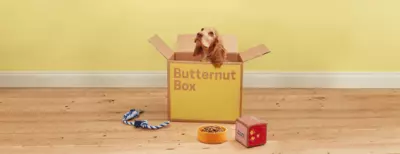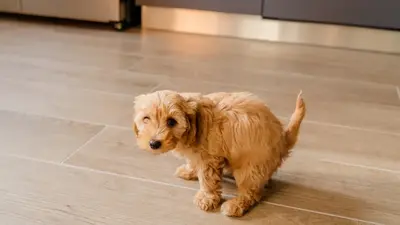Puppy training with treats
- 08 Apr 2021
- 6m read

By Sarah Connell-Sait, our Vet Nurse at Butternut Box
Before you bring your puppy home, it's a good idea to think about the basic rules you want your puppy to follow once they arrive. For example, will they be allowed upstairs or on the sofa? Will they have free run of the house or will they have a crate? Once you decide on these things, you can make it clear to your puppy and start good habits early. Consistency is the key here, so make sure everyone in the household is aligned with the rules and avoid anything confusing like allowing your puppy in the bed on a Sunday morning but not the rest of the week.
Between birth and 17 weeks old, all puppies go through a critical socialisation period. This means that all the experiences they have during this time can influence and shape their behaviour well into adulthood, so it's important to expose your little one to as many different experiences as possible to ensure they're a confident and happy adult.
This includes various loud noises such as fireworks, thunderstorms, ambulance sirens, loud traffic, crying babies, etc. You can find a lot of soundtracks online that contain all these noises so you can play them for your puppy and reward their good, calm behaviour with lots of fuss, positive words and little treats.
It's also a great time to encourage visiting family and friends (especially those with a beard) to wear hats, hoodies, sunglasses, and face masks when they come over. Try walking your puppy on different surfaces like gravel, sand, shiny floors, wood floors, and carpet. This is also a great time to prepare your puppy for experiences they might have at the vet, such as nail clipping, ear cleaning or being restrained; to do this, you can regularly pick up your puppy's paws and touch each nail, gently stroke them around the ears and lift their ear flap and gently wrap your arms around the front and back of their body and then release again. Once your puppy has been vaccinated you can also take them to puppy socialisation classes so they can meet other puppies of similar ages and experience new things together.
The key to puppy socialisation is to take small steps and introduce just one thing at a time to avoid overwhelming your little one and remember to reward your puppy's good behaviour with lots of praise and cuddles.
As your puppy is in a learning and development stage for much of their early life, it's a good idea to keep their brain busy with some fun puzzles and gentle training. Try offering a food puzzle such as a Kong filled with something tasty, like Butternut and encourage them figure out how to get the food out. You can use snuffle mats and other interactive feeders with a similar effect. There are also some fantastic books filled with brain activities that you can do with your puppy to keep them stimulated. This will help to burn off some of that mental energy that is in abundance during this part of their life.
When your puppy is settled into their new home and comfortable with their surroundings, you can start training them to follow simple commands such as 'sit', 'lay down', 'stay' and 'come'. Your puppy's attention is likely to be at it's highest after they've had a toilet break. Training your young puppy is also most successful in short bursts of 5 or 10 minutes, rather than trying to keep their attention for an hour.
Sit
Sit on the floor in front of your puppy and start by holding a tasty training treat in front of your puppy's nose, so they know what you've got! Raise your hand with the treat up and over their head, to encourage them to lift their head to look up and naturally sit. At the same time, verbally ask your dog to 'sit' in a calm voice (saying it louder doesn't help, trust us!). As soon as your clever puppy sits, reward them with their tasty treat straight away and give lots of cuddle and praise. Practice makes perfect, so remember to repeat these steps several times a day until your puppy understands.
Lay down
Great - your puppy is a pro at 'sit'! Time for 'lie down'. Once in a seated position, try holding a training treat between your puppy's front paws. When they lower their head, pull the treat towards yourself, encouraging your puppy to lay forward. At the same time, calmly ask your puppy to 'lie down'.
When they lie down, hand over the treat and give them lots of cuddles for being so clever. Again, keep practicing everyday.
Stay/Come
Once your puppy is well versed in 'sit' and 'lay down', you can move on to 'stay'. Start with your puppy in a sitting position whilst you stand. Put your hand up in front of you by your with your palm facing outwards towards your puppy and say 'stay'. Wait for a couple of seconds and if your puppy remains where they are, you can give them plenty of praise for doing so well. After doing this a few times, you can move on to the next step. This time, when asking your puppy to 'stay' with your palm facing them, take a step or two backwards. Wait for a few seconds and then reward your puppy if they stay.
Over the next few days and weeks, continue repeating these steps and gradually increase the number of steps you take away. You can then use the word 'come' to release your puppy at the end of every exercise by encouraging them to run to you and collect their reward.
Lots of affection and praise for good behaviour will help your puppy to understand how they fit in with their new family and most importantly, will help you to build a bond that will last a lifetime.
When it comes to food rewards for your puppy, you'll can trial having a variety of low-value and high-value treats. A low-value treat might be something like a chunk of raw carrot, or a piece of dry kibble. A high-value treat is one that your puppy goes crazy for and will pretty much do anything to get; usually something meaty like our Butternut lamb treats. The purpose of different value treats is so that you always have something to offer your puppy that's exciting every time. You can use these for particularly challenging tasks or to increase your puppy's motivation. However, some puppies might lose all sight of what they're supposed to be doing when presented with a high-value treat, so see how it goes and chose the option that works best for you both.
At Butternut, we'll always factor in your puppy's treat allowance when calculating their portion size.

.jpeg)
.webp)

